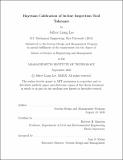| dc.contributor.author | Lee, Jeffrey Liang. | en_US |
| dc.contributor.other | Massachusetts Institute of Technology. Engineering and Management Program. | en_US |
| dc.contributor.other | System Design and Management Program. | en_US |
| dc.date.accessioned | 2021-10-08T16:59:04Z | |
| dc.date.available | 2021-10-08T16:59:04Z | |
| dc.date.copyright | 2020 | en_US |
| dc.date.issued | 2020 | en_US |
| dc.identifier.uri | https://hdl.handle.net/1721.1/132841 | |
| dc.description | Thesis: S.M. in Engineering and Management, Massachusetts Institute of Technology, System Design and Management Program, September, 2020 | en_US |
| dc.description | Cataloged from the official version of thesis. | en_US |
| dc.description | Includes bibliographical references (pages 65-67). | en_US |
| dc.description.abstract | Calibration of Magnetic Flux Leakage (MFL) In-line Inspection (ILI) tools is an important part of the overall pipeline integrity management process. Over-called or under-called corrosion features can have significant impacts on safety and resource management. This thesis examines methods for improving the Validation and Calibration processes using Bayesian Inference. The focus is on improving the tolerance that is applied to undug features to optimize the execution of risk-based repairs. A simulated data set was generated, with two separate categories, one which represents tool performance on basic features and another for challenging features. The calculated parameters of [alpha], [beta], and [sigma], were calculated using a Bayesian model leveraging a Markov Chain Monte Carlo simulator. The [sigma] parameter is used to determine the appropriate tolerance to apply and was compared with a [sigma] calculated via the method recommended by API 1163. Results from the example data set show that in challenged situations, the Confidence Level of the tool performance can be increased from 89% to 95% and the mean average error can be decreased using the Bayesian Inference model. Opportunities to use the methods outlined to improve other processes in ILI validation are discussed. By appropriately updating the likelihood used in the Bayesian model with dig data, the tolerance can more accurately represent the undug features and risk management decisions can be conducted accordingly. | en_US |
| dc.description.statementofresponsibility | by Jeffrey Liang Lee. | en_US |
| dc.format.extent | 67 pages | en_US |
| dc.language.iso | eng | en_US |
| dc.publisher | Massachusetts Institute of Technology | en_US |
| dc.rights | MIT theses may be protected by copyright. Please reuse MIT thesis content according to the MIT Libraries Permissions Policy, which is available through the URL provided. | en_US |
| dc.rights.uri | http://dspace.mit.edu/handle/1721.1/7582 | en_US |
| dc.subject | Engineering and Management Program. | en_US |
| dc.subject | System Design and Management Program. | en_US |
| dc.title | Bayesian calibration of in-line inspection tool tolerance | en_US |
| dc.type | Thesis | en_US |
| dc.description.degree | S.M. in Engineering and Management | en_US |
| dc.contributor.department | Massachusetts Institute of Technology. Engineering and Management Program | en_US |
| dc.identifier.oclc | 1263244318 | en_US |
| dc.description.collection | S.M.inEngineeringandManagement Massachusetts Institute of Technology, System Design and Management Program | en_US |
| dspace.imported | 2021-10-08T16:59:04Z | en_US |
| mit.thesis.degree | Master | en_US |
| mit.thesis.department | SysDes | en_US |
